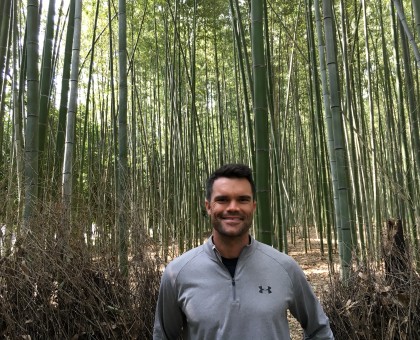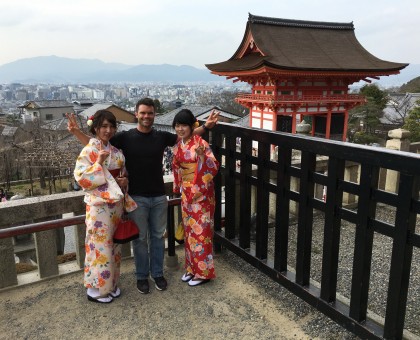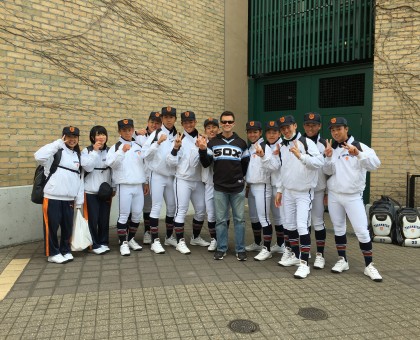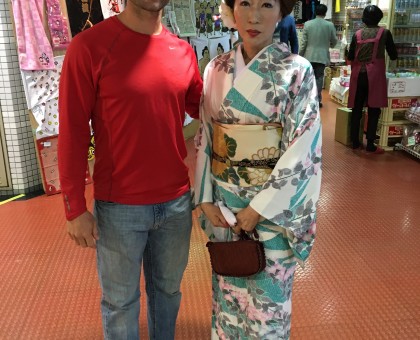.png)
I was fortunate enough to return to Japan for a second time in March 2016.
This trip combined business (baseball) with pleasure (traveling and sightseeing) and offered once-in-a-lifetime experiences.
The trip began on the island of Shikoku - located in the southern part of Japan - where I spent time in Matsuyama City in the Ehime Prefecture. Known for the popular Dogo Onsen (hot spring), and the Dogo Onsen Festival, Matsuyama was a great first stop. The festival featured colorful, authentic Japanese outfits, which were worn by men, women and children. Performances took place every night, and for hours on end, as a full ensemble of instruments (played by those dancing) provided the beat. After being encouraged by the locals, I mixed right in and joined some of the performances. It was delightful to engage in such a ritual.
A visit to the Matsuyama Castle offered beautiful panoramic views over the city, and my first glimpse at the pretty cherry blossoms Japan is known for. Cherry blossom season is in March and April, so my timing was perfect! The colors were aplenty, and very pretty.
After Matsuyama, it was on to Osaka, and to get there, I had to cross the Akashi Kaikyō Bridge, which connects Awaji Island with Kobe. The Akashi Bridge is the world’s longest suspension bridge. Spanning 3,911 meters (12,831 feet), this engineering marvel was quite the sight, and I had the opportunity to see it both during the day and at night. Looking across the Akashi Strait offered amazing views of the city of Kobe and its skyline, and I was reminded a lot of San Francisco.
Before crossing the Akashi Bridge, I took a break at a rest stop, where I had a couple new experiences. After looking at a few photos, I ordered my meal - udon noodles, beef and vegetables - from a machine, which produced a ticket, allowing me to collect my meal once it was finished. Talk about streamlining the process! Japan has it figured out. My dining experience was enhanced when Japanese high school baseball (Koshien Tournament) was playing on television. The meal was great, but I was more focused on watching the high-level high school baseball on TV.
Once on the other side of the Osaka Bay, I headed straight to the Osaka Prefecture Gymnasium to take in Japan’s national sport: sumo wrestling. Every year there are six Grand Sumo Tournaments throughout Japan, with each one lasting 15 days. Each wrestler - known as a rikishi in Japanese - has one bout (match) per day, so in total, there are around 70 wrestlers who compete on a daily basis during one of the Grand Sumo Tournaments. Although known as Japan’s national sport, sumo is so much more. It is a very precise, ritualistic martial art with an abundance of nuances that go back for centuries, and has deeply-rooted religious connections as well.
From wrestlers throwing salt in the ring (known as the dohyo in Japanese) before they enter, to their body-slapping to create blood flow and pump themselves up, there are plenty of idiosyncrasies. Similarly, each wrestler has his own form of pre-bout showmanship, and every bit of it is fascinating to observe. The pre-bout rituals, respect and showmanship is all a part of the sumo experience, and was truly magnificent to witness. Even the fans get involved, which I witnessed first-hand during the last bout of the evening. If a spectator disagrees with the judges’ decision for who won the bout, they throw their seat cushion high up into the air, sometimes sending it sailing several sections away. Seat cushions soared through the air when one of the three active yokozunas' (grand champions) bouts ended in slightly controversial fashion.
With more than 8,000 fans packed into the arena, the atmosphere gets more and more intense as the day goes on. Each day’s bouts begin around 2:30pm, and with 35 bouts to get through - starting with the lowest ranking wrestlers and ending with the yokozunas - the day of sumo ends around 6pm.
The rules of sumo are extremely simple. The bout begins as soon as both wrestlers’ hands have made contact with the ground. Typically, there is quite a bit of back and forth, as one wrestler will get into position, placing his hands on the ground between his legs in the ‘sumo squat’ position. As his opponent gets down into the same squatted position, preparing for the bout, oftentimes the wrestler already in position will then stand up and back away. These pre-bout tactics are quite common, and are used to test the opponent, or sometimes to intimidate them. It really gets the crowd into the bout as well, as everyone eagerly awaits the knuckles to contact the ground so the bout can begin.
The first wrestler to come into contact with the ground (inside the dohyo) with any body part other than his feet, is declared the loser. A wrestler is victorious is if he forces his opponent out of the dohyo. Just 4.55 meters (14.93 feet) in diameter, the dohyo is a relatively small space, especially for some of the biggest human beings on the planet. As such, spectators seated in the first couple rows of the arena stand a very good chance of (literally) coming into contact with a wrestler, as they sometimes get thrown out of the dohyo and off of the elevated platform. Although the average sumo bout only lasts a few seconds, there were numerous match-ups that went longer. No matter the length of the bout, however, all were quite entertaining.
Once a bout is over and the judge(s) have declared a winner, the winner stays in the dohyo as the loser exits. The winner squats down into a squatted position and goes through a series of hand motions as the judge stands in front of him. An envelope is handed to the winning wrestler, and then he exits the dohyo, done for the day.
Each envelope contains 60,000 Japanese Yen, which is approximately 530 U.S. Dollars. Five thousand of that goes to the sumo association to cover expenses, another 25,000 yen is withheld for income tax and for the wrestler’s retirement plans, etc., and the wrestler gets the remaining 30,000 yen in cash, on the spot, in the envelope. Depending on how deep in the Grand Sumo Tournament it is, or the significance of the particular bout, there could be a stack of up to 15 envelopes handed to the winning wrestler.
As my sumo experience went along, I was intrigued with the wrestlers. It was almost like being in the presence of an extinct animal. It felt so surreal to be amongst these beasts. I was so intrigued, in fact, that I wanted to get closer to them. Curious about these fascinating creatures, I ducked beneath the main seating area to see them up close. Boy am I glad I did?! There are two changing/dressing rooms, and the wrestlers are divided so those facing each other are in different rooms. The yokozunas have their own changing/dressing room, but the great part about all of this is that the wrestlers have to walk amongst the general public to get to the pathway that leads to the dohyo. Having mastered some phrases in Japanese, I was able to interact with the wrestlers, and asked several of them if I could get my photo taken with them. Most of them were very open to me taking a photo with them, but some were not. Thankfully those who weren’t interested in being photographed didn’t do anything other than shake their head or ignore me altogether. It would have been an ugly sight if things got physical.
Seeing the wrestlers face to face gave me an entirely new appreciation for their size. With an average height of 185 centimeters (6’1”) and weight of 148 kilograms (326 pounds), sumo wrestlers are enormous individuals. The wrestlers are amazing athletes, possessing mobility, balance, strength and power that is nothing short of spectacular. The amount of force they hit one another with is hard to fathom, unless it is seen (and heard) in person.
After sumo, I explored Osaka, taking in its evening sights, sounds and smells. Osaka is a busy, bustling city of 2.7 million inhabitants, and is most known for its delightful cuisine. Lining the streets of downtown Osaka were scores of food stalls and restaurants where, truthfully, any and every Japanese dish could be purchased.
Once I was content with my adventures in Osaka, I returned to Kobe, where I was staying. Traveling by subway, the journey from Osaka took just over an hour. The subway seats were quite comfortable, and i felt like I was in a friend’s living room, as the soft and comfortable seats tempted me to take a nap.
My next Japanese adventure took me to Kyoto, which was Japan’s first capital city before Tokyo took over this title in 1869. Kyoto is known for its rich history, which can be seen at every turn. Temples and historic structures are scattered across the sprawling city. I checked out the famous Kinkaku-ji Buddhist Temple, which is a gorgeous golden pavilion with a pond directly in front of it. The sun glows beautifully off of the golden pavilion, practically creating a mirror image of the temple. It was quite the picturesque landscape.
After my time at the Kinkaku-ji Temple, I headed across Kyoto to visit the Kiyomizu-dera Temple. Trekking uphill along a narrow street to reach the temple gave me the first real taste of how popular it was going to be. Shops and restaurants lined the cozy pathway to the base of the temple, and as I waded through the sea of people to get to the top of the street, I could see the colorful towers anchoring the sacred grounds. Boasting a powerful orange color, the towers were very eye-catching, a photographer’s dream. With the ever-popular cherry blossoms starting to bloom, the vibrant pinks, whites and purples provided a gorgeous foreground for my panoramic views over Kyoto. After wandering through the temple grounds, I stepped into numerous shops and food stalls to finish off my time in Kyoto.
After exploring Kyoto, I returned to Kobe. As one of Japan’s most popular port cities, Kobe is extremely modern and very eclectic. The Kobe Port Tower - lit up with bright orange lights - pops up in the city’s skyline, and is one of its most popular landmarks. In Kobe, I had yet another unique Japanese dining experience, as I stumbled upon an udon noodle bar for an evening meal. Thinking I was entering a typical sit-down restaurant, it quickly became clear that I was stepping into an altogether different setup. A small counter - about stomach height - lined the ‘kitchen’ where the food was prepared, and with no chairs or tables in sight, it was obvious that I was going to be eating from the counter, while standing. I was totally okay with this, and embraced the opportunity to chalk up a new experience. Ordering my food in Japanese, I watched the ‘chef’ prepare it and serve it to me. This process, from placing my order to having my meal - udon noodles, beef and vegetables - in front of me, took less than two minutes. Eating with chopsticks, I wholeheartedly bought into the Japanese eating philosophy, as I got my face as close to the bowl as I could, and slurped the noodles right from the chopsticks and into my mouth. In some cultures, making such noises while eating would be viewed as rude or disrespectful, but in Japan it is completely accepted, and done by everyone. I got amongst it and joined right in!
My time in Japan was capped off with a trip to the famous Hanshin Koshien Stadium in Osaka, where I had the privilege of watching one of Japan’s most storied sporting events, the Koshien Baseball Tournament. Rich in history - the tournament has taken place for the last 88 years - Koshien is a nationwide high school baseball tournament held in Osaka twice each year (spring and summer), where one team from each of Japan’s 47 prefectures is represented. Two weeks in length, the single-elimination tournament essentially brings the country to a standstill, as all games are aired live on national television and are very well attended. Prior to attending Koshien, I had what I would call a decent understanding of the Japanese baseball culture. As such, I had certain expectations for what I would see at Koshien. Little did I know, I was in for a treat.
I was absolutely blown away by the talent level of these 16- and 17-year-old ballplayers. Their ability between the lines was astounding. All players were advanced beyond their years. Pitchers worked very quickly, got ahead of hitters and pitched to contact. They held runners very well and were extremely quick to the plate. Catchers worked quickly with the pitchers and kept a great tempo. All four catchers I watched during the two games at Koshien, had guns for arms. It was impressive. The infielders were most impressive, as they were fearless, putting their bodies in front of every single groundball. Plays that most westerners would turn into backhands were balls that the Japanese high school players got in front of, and then utilized their incredible arm strength to fire a missile across the diamond.
As much as the talent was strong, the players’ general discipline and overall respect for the game and every single element associated with it, was even more impressive.
The starting lineup’s numbers match their position numbers (i.e. the pitcher’s jersey number is 1, catcher’s is 2, etc.) on the field, which is an easy way to reference who is who on a team or during a game. It also shows spectators who the team’s top players are, and serves as a ranking system for each team. This hierarchy of players was very obvious during the pre-game infield/outfield that each team took on the field. It was hands down the most efficient and intense pre-game routine I’ve ever seen, and I absolutely loved watching all seven minutes of it. After infield/outfield, both teams line up in front of their respective dugouts, and then in unison, charge out to home plate and line up in fair territory out towards the mound. It is here that the respect for the game, the field, umpires and opponent is shown. Players bow to each other, and then to the umpire, and both teams shake hands before the visiting team returns to the dugout (sprinting) and the home team sprints out to their positions for the start of the game.
The starting pitcher gets seven warm-up pitches before the first inning, and then three warm-up pitches every inning thereafter. As an American, this is very different, but it speaks volumes to the tempo and efficiency of the games played at Koshien. At the conclusion of each half-inning, no matter how the out is made, the baseball is placed (by a player on the defensive team) on the dirt in front of the pitcher’s plate. Not much time passes when the ball hits the ground and the opposing pitcher is picking it up to make his warm-up pitches for the next half-inning.
Another element of Japanese baseball which is completely different to that of baseball in North America, is the spectators. Each team participating in Koshien has its own cheering section, separate to the rest of the fans. This section features hundreds of supporters, all wearing the same outfit and donning their school’s colors. This section also has a band, fully equipped with every instrument the college marching band would have at an SEC football game. Cheerleaders wave pom-poms throughout the game, and assist in leading chants and sing-alongs to the band’s songs. From the first pitch until the last, both teams’ bands and cheering sections are making noise. It is an incredible sight…and sound, especially at a (high school) baseball game.
When the game ends, the winning team stands at home plate - in a single file line facing center field - and their school song is played throughout the entire stadium. The losing team stands - in a single file line facing the field - in front of their dugout, and as soon as the song is finished, each team sprints out to foul territory in front of their respective cheering section, and bows to the crowd that supported them throughout the game. Just another form of respect and gratitude. I think I had goosebumps the entire time I was at Koshien.
I could go on and on about Koshien, and how much detail and precision there is with anything done on the field. Attending games at the 88th Koshien Tournament had a strong impact on me as a baseball lifer, but also as a human being. This experience is one I will never forget, and will reflect on frequently.
My trip to Japan could not have ended on a better note.






























































